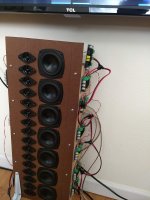Experimenting with a CBT column speaker to reduce hard floor reflections in a center channel. Allen B and others have mentioned in-wall speaker placement = boundary advantages.
My question: when is a speaker "in-wall"?
In this case, the speaker baffle is five inches off the wall. Does that mean the speaker is in-wall for frequencies longer that 5 inches long (~ 2700Hz)?
My question: when is a speaker "in-wall"?
In this case, the speaker baffle is five inches off the wall. Does that mean the speaker is in-wall for frequencies longer that 5 inches long (~ 2700Hz)?
Attachments
There are (at least) two factors to consider for this; baffle diffraction and radiation pattern. With an ideal in-wall speaker you have practically no diffraction from a baffle edge, and there's no transition to full-space radiation, in theory.
In your case you still have baffle diffraction, but you probably won't get the full -6 dB baffle step into full-space.
In your case you still have baffle diffraction, but you probably won't get the full -6 dB baffle step into full-space.
Too late to edit my previous post - have you measured the speaker in-position with no low-frequency EQ? You should be able to see how tell how much BSC is required and identify accordingly how closely this matches an "in-wall" setup.
Too late to edit my previous post - have you measured the speaker in-position with no low-frequency EQ? You should be able to see how tell how much BSC is required and identify accordingly how closely this matches an "in-wall" setup.
Yes, but I was thinking about using the TV screen as the baffle on top and widening the side baffles. Floor to top of TV is 62 1/2". At that point I'll run into a 5 inch step from the TV screen back to the wall. Unless I build a baffle above the TV screen.
In this case I was wondering if a baffle as wide as the TV would eliminate baffle step because by the time it got to the edge w/ the 5" step the wavelengths would be too large to matter.
Should not CBT be curved?
Yes, always. In this case it is curved by DSP delay. As it is set up right now it the 3" speakers are arranged into 3 banks. Bank 1 is first bottom 4 speakers. Bank 2 is next two speakers. Bank 3 is the last speaker. Banks 2 & 3 are time delayed to approximate an arc of 36 degrees. Using more banks would allow a closer approximation. However, I'm not sure if adding more banks for a closer approximation is worth it. At some point you might as well physically curve the arc.
An advantage of a flat time delayed CBT is that you can quickly change the arc curvature. A larger arc curve will result in a larger vertical beamwidth. Smaller = smaller vertical beamwidth. The formula is arc degrees x 75%.
In the case of a center channel I'd want to set the vertical beamwidth to be a little higher than the seated audience. Adjusting the virtual arc will help me decide if I recognize a difference or not.
Last edited:
